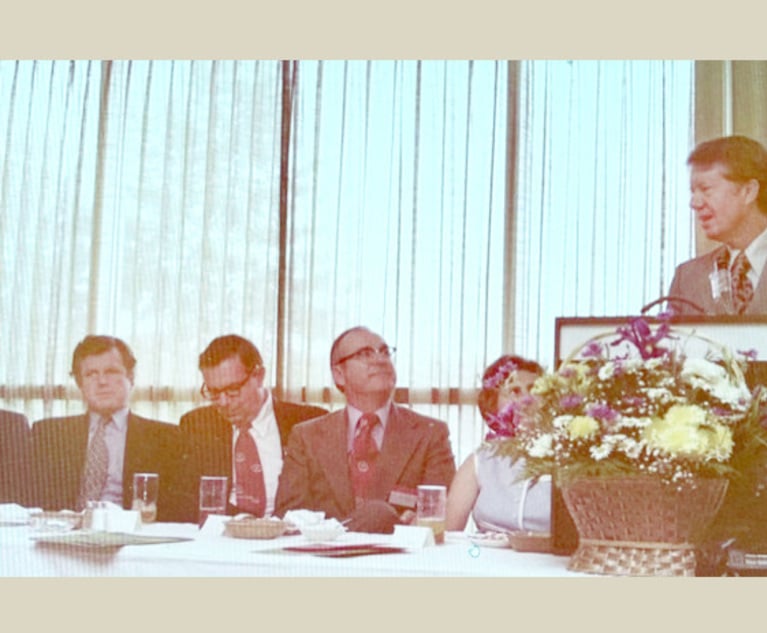Looking Beyond Statistical Diversity
We must address implicit bias in order to foster a culture of inclusion and belonging.
September 19, 2019 at 10:59 AM
6 minute read

From the Editor: Today, we present the third column in our National Law Journal series, "On the Rise: Voices from Young Lawyers." Meghan Hottel-Cox, one of our 2019 D.C. Rising Stars, is a real estate attorney at Goulston & Storrs and plays a key role in her firm's diversity efforts. (In September, the firm was named one of Diversity Lab's Mansfield 2.0 Certified Plus firms.) It's the latest installment of our series where leading young lawyers tackle key practice topics and discuss their lives in the district and beyond. —Lisa Helem, editor-in-chief, The National Law Journal
The legal industry continues to lag behind other industries in diversity. But, in the last decade, our industry has slowly improved, at least statistically. How do we look beyond the statistics and create meaningful change that permeates the upper-echelons of the legal world?
Merriam-Webster defines diversity as "the condition of having or being composed of differing elements." But real diversity in a legal organization goes far beyond simple composition – it hinges on a truly diverse culture that reaches beyond statistical representations. To create this diverse culture, to maintain and improve "statistical diversity" at all levels of an organization, requires focusing beyond numbers to less tangible factors like feelings of inclusion and belonging. For inclusion and belonging to flourish, organizations must create a culture where people of every race, gender, sexual orientation, ability, age and any other identity markers can thrive as an inherent part of the organization's identity and structure.
A good way to assess how well your organization's culture embraces inclusivity and belonging is to look at mentorship and sponsorship. Success in the legal industry often stems from learning from the best, and receiving advice, guidance, and leadership from others. Examining which junior attorneys your senior attorneys provide wisdom and guidance to (mentorship) or go to bat for with their colleagues, promoting their advancement (sponsorship) provides critical insight into your organization's values and culture.
Moving Past the Looking Glass
Often, senior attorneys look to mentor or sponsor those who remind them of themselves. This (usually) unconscious search for someone who could follow their same path leads to someone who looks like the senior attorney. In an industry that is disproportionately white, male and straight, this cycle not only perpetuates the lack of statistical diversity in upper levels of an organization, but also highlights the blind spots in our organizations' focus on inclusion and belonging.
 The self-selection of perpetuating demographics through mentorship and sponsorship is an example of the results of implicit bias. In an effort to sort through the incredible amount of information our brains must process every day, our brains unconsciously create pre-programmed categories, processes, and judgments to ease that process. These implicit thoughts and actions are formed by the things that surround us – media, news, societal norms, and experience.
The self-selection of perpetuating demographics through mentorship and sponsorship is an example of the results of implicit bias. In an effort to sort through the incredible amount of information our brains must process every day, our brains unconsciously create pre-programmed categories, processes, and judgments to ease that process. These implicit thoughts and actions are formed by the things that surround us – media, news, societal norms, and experience.
Our implicit biases are formed without intention, but can affect almost all of our actions – especially if we are unaware of how they work. Our implicit biases are not always self-serving, especially if we occupy any non-dominant demographic. For example, as a lesbian who has been married to my wife for almost a decade, I still find myself assuming each new person I meet fits into the status-quo of opposite-sex relationships unless I'm given evidence otherwise. Implicit biases affect us all.
Recognizing our implicit biases is of vital importance. Only once we are aware that we have these biases can we begin the crucial work of correcting those biases on a personal level. Acknowledging and counter-acting these biases allows us to create a more equitable environment around us – one that is more inclusive of all and creates a space of belonging.
This awareness is a critical first step not only for individuals but for organizations. A group of people who all have individual implicit biases work in organizations with structures, policies and cultures that often perpetuate those biases. Only by becoming aware, accepting, and addressing our implicit biases can we start to counteract those biases and improve organizational cultures to value inclusivity and belonging.
Building a More Diverse and Inclusive Culture
How do we, as individuals and organizations, start to acknowledge and address our implicit biases? I serve on my firm's Inclusionary Advisory Committee, and we grappled with this exact question. We began this conversation at our firm in two ways. First, at a kick-off event for our firm's affinity groups, we had attendees take an implicit bias test from Harvard's Project Implicit and had small group discussions to talk about the results. These conversations helped us recognize our biases and created space to have meaningful, often difficult conversations about them. Second, and more formally, we brought in an outside consultant to conduct mandatory, firm-wide implicit bias training. These small group training sessions provided context, open dialogue, and tools to understand and counteract implicit bias. These events created opportunity for ongoing conversations around implicit bias and how it is part of our firm's culture.
Acknowledging and recognizing implicit bias is only the first step, but it is an important one. Implicit bias training is not a "check-the-box" easy solution to challenges around diversity, inclusion and belonging. But it is key to addressing hurdles within our organizations and ourselves to create truly equitable environments.
Understanding that we all have biases, we are better able to hold ourselves and others accountable. When we see who is being mentored and sponsored, we can ask – is this reflective of a culture that values diversity, inclusion, and belonging? And, more importantly, is this who we want to be?
Building a diverse, inclusive, and belonging culture requires hard work, tough conversations, and intense focus. But in an industry focused on representation, advocacy, and, at its core, equality in the law, creating a more equitable legal industry – through diversity, inclusion, and belonging – should unite us all. Conversations that recognize the implicit biases we face as individuals, organizations, and as an industry start the process to producing meaningful change. They are by no means the end, but rather the beginning, of our journey to equity.
Meghan Hottel-Cox is an attorney at Goulston & Storrs focusing on land use law and a co-founder of Q City, an LGBTQ-affinity group for commercial real estate professionals in DC.
The National Law Journal will host its annual legal awards honoring our 2019 D.C. Rising Stars and other honorees on October 30 at the Mayflower Hotel in Washington, DC. For more information, visit this site.
This content has been archived. It is available through our partners, LexisNexis® and Bloomberg Law.
To view this content, please continue to their sites.
Not a Lexis Subscriber?
Subscribe Now
Not a Bloomberg Law Subscriber?
Subscribe Now
NOT FOR REPRINT
© 2025 ALM Global, LLC, All Rights Reserved. Request academic re-use from www.copyright.com. All other uses, submit a request to [email protected]. For more information visit Asset & Logo Licensing.
You Might Like
View All
Switching Positions: US Solicitors General and Climate Change Lawsuits
6 minute read
Jimmy Carter’s 1974 Law Day Speech: A Call for Lawyers to Do the Public Good
14 minute readTrending Stories
Who Got The Work
Michael G. Bongiorno, Andrew Scott Dulberg and Elizabeth E. Driscoll from Wilmer Cutler Pickering Hale and Dorr have stepped in to represent Symbotic Inc., an A.I.-enabled technology platform that focuses on increasing supply chain efficiency, and other defendants in a pending shareholder derivative lawsuit. The case, filed Oct. 2 in Massachusetts District Court by the Brown Law Firm on behalf of Stephen Austen, accuses certain officers and directors of misleading investors in regard to Symbotic's potential for margin growth by failing to disclose that the company was not equipped to timely deploy its systems or manage expenses through project delays. The case, assigned to U.S. District Judge Nathaniel M. Gorton, is 1:24-cv-12522, Austen v. Cohen et al.
Who Got The Work
Edmund Polubinski and Marie Killmond of Davis Polk & Wardwell have entered appearances for data platform software development company MongoDB and other defendants in a pending shareholder derivative lawsuit. The action, filed Oct. 7 in New York Southern District Court by the Brown Law Firm, accuses the company's directors and/or officers of falsely expressing confidence in the company’s restructuring of its sales incentive plan and downplaying the severity of decreases in its upfront commitments. The case is 1:24-cv-07594, Roy v. Ittycheria et al.
Who Got The Work
Amy O. Bruchs and Kurt F. Ellison of Michael Best & Friedrich have entered appearances for Epic Systems Corp. in a pending employment discrimination lawsuit. The suit was filed Sept. 7 in Wisconsin Western District Court by Levine Eisberner LLC and Siri & Glimstad on behalf of a project manager who claims that he was wrongfully terminated after applying for a religious exemption to the defendant's COVID-19 vaccine mandate. The case, assigned to U.S. Magistrate Judge Anita Marie Boor, is 3:24-cv-00630, Secker, Nathan v. Epic Systems Corporation.
Who Got The Work
David X. Sullivan, Thomas J. Finn and Gregory A. Hall from McCarter & English have entered appearances for Sunrun Installation Services in a pending civil rights lawsuit. The complaint was filed Sept. 4 in Connecticut District Court by attorney Robert M. Berke on behalf of former employee George Edward Steins, who was arrested and charged with employing an unregistered home improvement salesperson. The complaint alleges that had Sunrun informed the Connecticut Department of Consumer Protection that the plaintiff's employment had ended in 2017 and that he no longer held Sunrun's home improvement contractor license, he would not have been hit with charges, which were dismissed in May 2024. The case, assigned to U.S. District Judge Jeffrey A. Meyer, is 3:24-cv-01423, Steins v. Sunrun, Inc. et al.
Who Got The Work
Greenberg Traurig shareholder Joshua L. Raskin has entered an appearance for boohoo.com UK Ltd. in a pending patent infringement lawsuit. The suit, filed Sept. 3 in Texas Eastern District Court by Rozier Hardt McDonough on behalf of Alto Dynamics, asserts five patents related to an online shopping platform. The case, assigned to U.S. District Judge Rodney Gilstrap, is 2:24-cv-00719, Alto Dynamics, LLC v. boohoo.com UK Limited.
Featured Firms
Law Offices of Gary Martin Hays & Associates, P.C.
(470) 294-1674
Law Offices of Mark E. Salomone
(857) 444-6468
Smith & Hassler
(713) 739-1250












